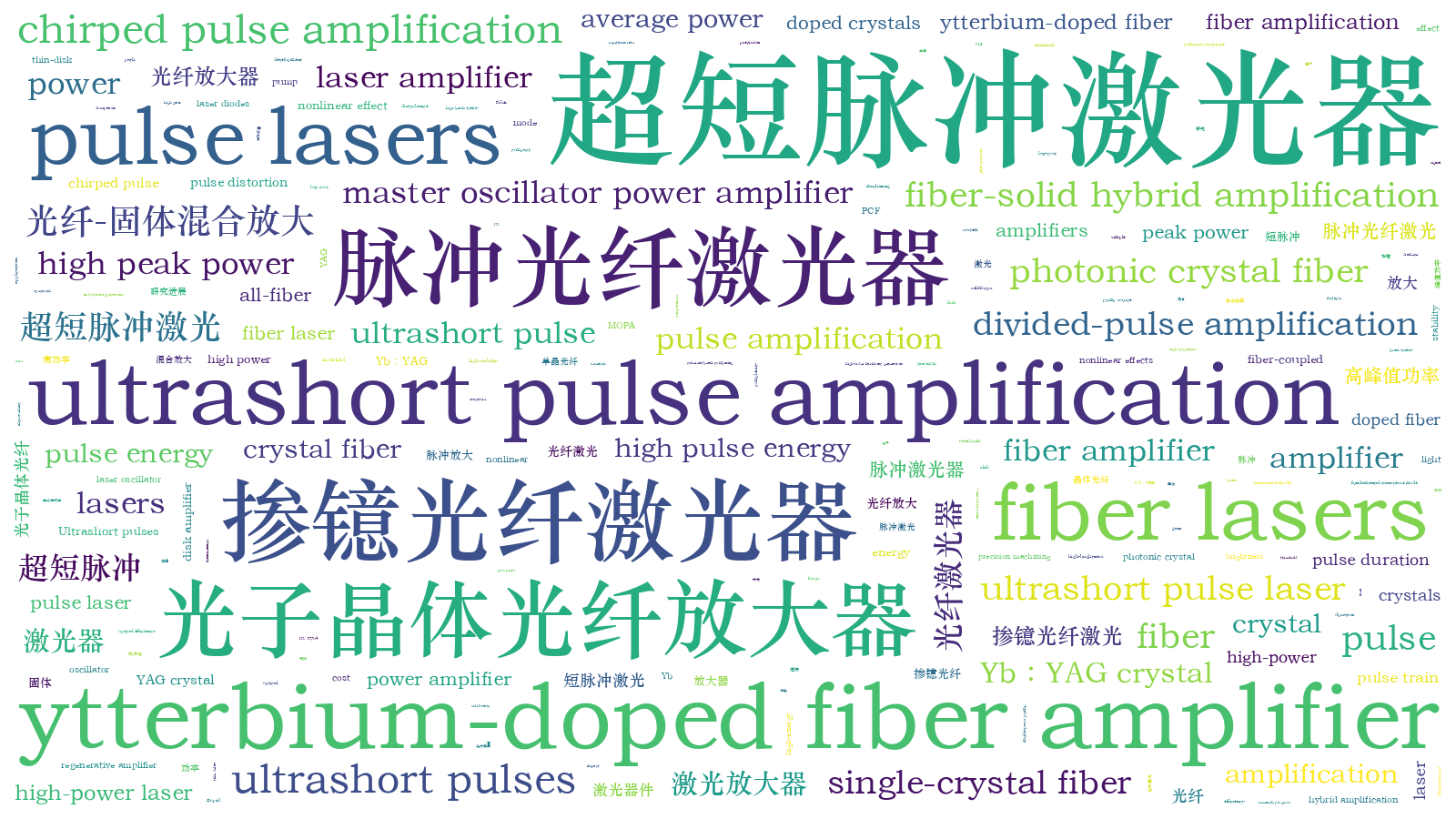掺镱光纤-固体高功率超短脉冲放大研究进展  下载: 1887次特邀综述
下载: 1887次特邀综述
Significance High-power ultrashort pulse lasers have significant applications in the fields of industrial high-end precision machining, high-order harmonic generation, and spectroscopy. Since the 21st century, countries around the world have successively launched their own manufacturing upgrade plans to focus on the development of high-end precision machining. This puts forward higher requirements for ultrashort pulse lasers and makes them toward the direction of high power, compact structure, high stability, low cost, simple operation, and maintenance.
The average power of an ultrashort laser oscillator does not meet the requirements of high-end precision machining. Therefore, it is necessary for further amplification by using the master oscillator power amplifier (MOPA), regenerative amplifier (RA), chirped pulse amplification (CPA), divided-pulse amplification (DPA), coherent beam combining (CBC), etc. An RA provides 60 dB pulse energy amplification, but however, the Pockels cell inside the RA cavity requires high-voltage driving which reduces stability. CBC can be realized by using multiple amplifiers and multiple time delay line, and it is sensitive to the environmental disturbance. As a result, MOPA, CPA, and DPA are often used to obtain low-cost, high-stability, and high-power ultrashort pulse lasers. The gain materials used in the amplification technologies mentioned above can be categorized as fiber, rod or bulk crystal, slab crystal, thin-disk crystal, and single-crystal fiber (SCF).
Ytterbium-doped fiber is widely used in the ultrashort pulse oscillator and amplifier due to its large gain spectrum bandwidth, high optical-to-optical efficiency, and high beam quality. However, the limited core diameter of fiber causes strong nonlinear effects, pulse distortion, and even damage when high-peak power pulses pass through. In order to reduce the nonlinear effect of fiber while maintaining the fundamental transverse mode, two solutions have been investigated. One is to stretch pulse duration and compress pulse duration after amplification, which is a well-known CPA technology; the other is to expand fiber mode field area, which uses a large mode field photonic crystal fiber (PCF). The restriction for single-channel ultrashort pulse amplification is a self-focus nonlinear effect; the threshold is usually lower than 4 MW. CBC technology can avoid self-focus effect and can further increase average power to 10 kW. Nonetheless, the CBC system increases complexity and cost.
The most commonly used crystals for ultrashort pulse amplification are neodymium-doped crystals and ytterbium-doped crystals, for instance, Nd∶YVO4, Nd∶YAG, and Yb∶YAG. Compared with Nd3+ doped crystals, Yb3+ doped ones exhibit small quantum defect, wide spectrum bandwidth, and weak concentration quenching effect. Yb∶YAG crystal shaped in slab or thin-disk configuration, pumped by high-power laser diodes, can realize ultrashort pulses with kilowatt average power. However, a slab crystal amplifier contains a signal shaping system with a complex pump light path; a thin-disk crystal amplifier needs multi-pass pump light path and signal light path. Therefore, the high complexity and high cost of these two structures are inevitable.
The SCF amplifier developed in recent years has promising application prospects. Side-polished thin Yb∶YAG crystal is soldered in heat-sink with minimalized void rate, enabling pump light to travel in a waveguide. Large mode area, excellent heat-dissipation, and high-brightness pump improve its optical-to-optical efficiency, average power, and peak power simultaneously. With the continuous improvement of the brightness of fiber-coupled laser diodes, the amplification ability of SCF and rod (bulk) crystals will be further improved. Therefore, it is possible to obtain simple, cost-effective, reliable high-power, and high-energy ultrashort pulse laser by combining the fiber front-end and SCF or rod (bulk) crystal amplifier. This kind of amplification technology can not only be directly used in industrial applications, but also can be used as the front amplification stage for the slab and thin-disk amplifier, which greatly reduces the complexity and the cost.
This article summarizes the domestic and abroad research progress of ytterbium-doped fiber lasers, PCF amplifiers, SCF amplifiers, and rod (bulk) solid-state amplifiers in recent years, highlights our work in the fields of ultrashort pulse fiber lasers, PCF amplifiers, and solid-state amplifiers, and discusses and prospects the future development direction of hybrid amplification technology.
Progress The beginning of ultrashort pulse amplification is a mode-locked oscillator. The stability of the mode-locked pulse train has a significant impact on amplified pulse train. Therefore, a polarization-maintained (PM) mode-locked all-fiber laser with strong resistance to environmental disturbance is preferred. In recent years, a PM all-fiber oscillator has been widely investigated (
Conclusions and Prospects Ytterbium-doped fiber lasers are widely used because of their compact structure, high stability, and simple maintenance. However, the limited core diameter restricts the peak power of ultrashort pulses. The threshold of self-focus nonlinear effect of quartz materials limits the amplified peak power. This limitation can be effectively overcome by using ytterbium-doped crystals. Fiber-crystal hybrid ultrashort pulse amplification effectively combines the high gain of fiber amplifier and the high peak power and high pulse energy of the crystal amplifier. By employing the CBC technology and a high brightness pump source, the amplification efficiency, amplified average power, and amplified pulse energy will be further improved. The development of efficient room temperature heat-dissipation technology is a direction for future investigation.
徐岩, 彭志刚, 程昭晨, 石宇航, 王贝贝, 王璞. 掺镱光纤-固体高功率超短脉冲放大研究进展[J]. 中国激光, 2021, 48(5): 0501003. Yan Xu, Zhigang Peng, Zhaochen Cheng, Yuhang Shi, Beibei Wang, Pu Wang. Research Progress of Ytterbium-Doped Fiber-Solid High-Power Ultrashort Pulse Amplification[J]. Chinese Journal of Lasers, 2021, 48(5): 0501003.







